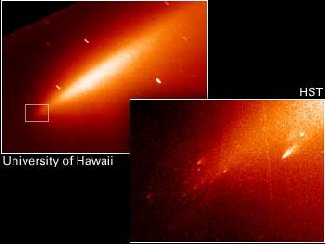The left-most picture here was taken by a ground-based telescope run by the University of Hawaii. In this image, Comet Linear appears as a diffuse, elongated cloud of debris without any visible nucleus. The image on the right was taken by the Hubble Space Telescope on the same day, August 5, 2000. Hubble's resolution was needed to show that the nucleus of the comet had actually fragmented into many pieces. Scientists call these leftover pieces "cometesimals". Hubble has found at least 16 of these "cometesimals", some of which are as wide as 330 feet across.
Click on image for full size
NASA, Harold Weaver (Johns Hopkins University), and the HST Comet LINEAR Investigation Team
Related links:
Comet Section
The Amazing, Vanishing Linear!
News story originally written on May 25, 2001
Comet Linear was discovered on September, 27, 1999, by the Lincoln Near-Earth Asteroid Research program.
Astronomers thought LINEAR would not be as spectacular as other recent comets like Hyakutake and Hale-Bopp. After all, it was much dimmer than these comets. But, LINEAR did put on a tremendous show for the Hubble Space Telescope. The Hubble was tracking the comet for two days, July 5-7, 2000. On July 5, 2000, comet Linear blew off a piece of its crust. The Hubble telescope watched the light brighten by an extra 50% in less than four hours. The eruption threw off a great deal of dust into space.
Then, when comet Linear came closest to the Sun on July 26, 2000 (still 114 million kilometers away though!), the comet nucleus broke apart!
Now comet Linear is little more than a trail of debris orbiting the Sun.
Astronomers have been studying the comet since last summer when it broke apart. Using a variety of telescopes, astronomers have seen leftover pieces of Linear as small as a smoke particle and as big as a football field! But it's the material astronomers don't see that remains a mystery! Astronomers haven't found the intermediate-sized pieces of the comet that would confirm theories as to how big the nucleus of Linear was before it broke apart. In other words, researchers have found there is not as much material in the fragments as there was in Linear before it broke apart. The leftover material just wouldn't add up to a comet as large as Linear.
Further studies of debris left by this comet may change what scientists think of comet Linear's nucleus and comet structure in general.
You might also be interested in:
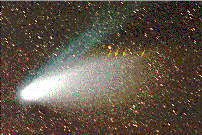
Hale-Bopp continues to offer surprises as astronomers study the comet. Using the Hubble Space Telescope and the International Ultraviolet Explorer, astronomers have found that there are distinctly different
...more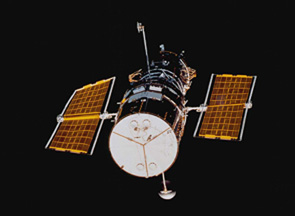
The Hubble Space Telescope (HST) was one of the most important exploration tools of the past two decades, and will continue to serve as a great resource well into the new millennium. The HST is credited
...more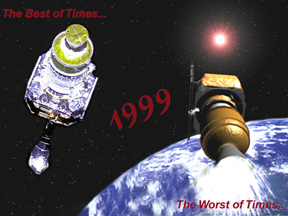
It was another exciting and frustrating year for the space science program. It seemed that every step forward led to one backwards. Either way, NASA led the way to a great century of discovery. Unfortunately,
...more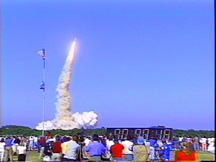
The Space Shuttle Discovery lifted off from Kennedy Space Center at 2:19 p.m. EST, October 29th. The sky was clear and the weather was great as Discovery took 8 1/2 minutes to reach orbit for the Unitied
...more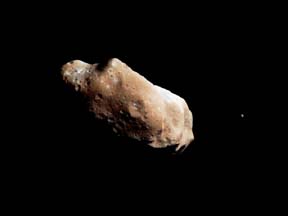
A moon was discovered orbiting the asteroid, Eugenia. This is only the second time in history that a satellite has been seen circling an asteroid. A special mirror allowed scientists to find the moon
...more
Will Russia ever put the service module for the International Space Station in space? NASA officials are demanding an answer from the Russian government. The necessary service module is currently waiting
...more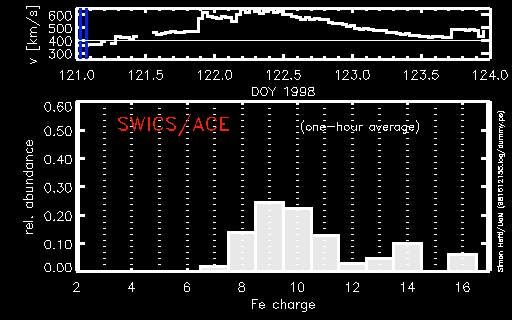
During a period of about two days in early May, 1998, the ACE spacecraft was immersed in plasma associated with a coronal mass ejection (CME). The SWICS instrument on ACE, which determines unambiguously
...more


